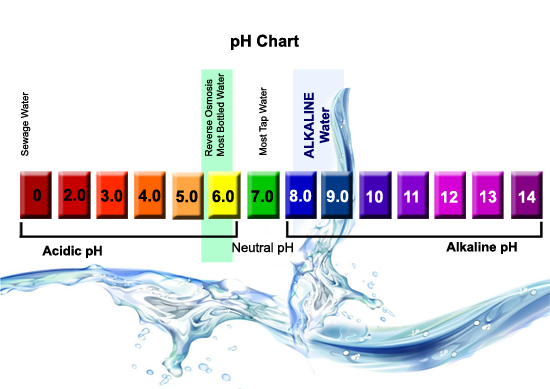Let’s break this down into a beginners basic form:
 The pH scale runs from 0 (acidic) to 14 (basic or alkaline) with 7 as neutral. Most water will test at a pH of 7. Sulphuric acid has a pH of almost 0, and is extremely acidic and highly corrosive. At the opposite end of the scale, lye has a pH of nearly 14. Lye is also highly corrosive, but that’s because it’s extremely alkaline. You don’t want to be consuming anything that has a 0 acidic level nor a highly corrosive high alkaline level.
The pH scale runs from 0 (acidic) to 14 (basic or alkaline) with 7 as neutral. Most water will test at a pH of 7. Sulphuric acid has a pH of almost 0, and is extremely acidic and highly corrosive. At the opposite end of the scale, lye has a pH of nearly 14. Lye is also highly corrosive, but that’s because it’s extremely alkaline. You don’t want to be consuming anything that has a 0 acidic level nor a highly corrosive high alkaline level.
The human body needs to maintain a pH in a narrow range, between 7.3 and 7.4, to function properly. This pH range provides the ideal working environment for the body to function naturally “on it’s own steam”. Your stomach is acidic translating to about 3.5 on the pH scale. It must remain so in order to break down food. Your blood is for the most part neutral which enables it to move various substances around the body without affecting or reacting to them.
The wrong pH can affect your health adversely. An perfect example of this is the inside of your stomach is lined with a thick layer of mucus that protects it from being digested along with food. The small intestine however isn’t as well protected. The stomach contains alkaline bile that is released into the small intestine to buffer and balance the acidity of the gastric acid secreted from the stomach.
Overall Health and the Body’s pH:
As you can see proper pH is crucial to your health and an extreme pH imbalance can be fatal.
Alkalosis occurs when your blood and other fluids become too alkaline. It’s a condition that can be caused by liver or lung disease, low oxygen levels, or a sudden loss electrolytes. Symptoms include confusion, lightheadedness, twitching and spasming muscles, seizure, tingling in the extremities and face, and respiratory distress.
On the flip side acidosis is characterized by a high acid load in the body’s fluids. There are several different types of acidosis: metabolic, respiratory, lactic, and renal (kidneys). Symptoms include confusion, fatigue, shortness of breath, and lethargy.
Metabolic acidosis comes into play when too a diet high in animal products and not enough fruits and vegetables, are consumed. Metabolic acidosis increases your risk of developing cardiovascular disease, diabetes, insulin resistance, and kidney stones. It causes kidney damage, which contributes to metabolic acidosis.
How Does Your Body Compensate for an unbalanced pH Level?
The kidneys are one of the body’s primary defenses against acidosis. They accomplish this by sending excess metabolically-produced acids to your bladder to be eliminated via urine. They also maintain tight control over bicarbonate, which can act as either a base or an acid depending on what it reacts with. When kidney function is compromised the body is less equipped to control its acid load, which leads to an even higher acid load. This condition may worsen with age if kidney function continually decreases. Following an alkaline diet for those dealing with Diabetes is one of the best kept secrets of our Wellness Industry.
The ability of the kidneys to filter acid is not the body’s only mechanism to control its acid load; the lungs assist as well. Carbon dioxide is a product of cellular metabolism and it becomes acidic in the blood. Cellular metabolism can break down organic matter, a process known as catabolism. Cellular metabolism can also produce substances, a process referred to as anabolism. To provide a more graspable example, breaking down food so the nutrients can be utilized is a catabolic reaction.
The production of proteins from amino acids is an example of an anabolic reaction. In simple terms: breaking down releases energy and building up consumes energy. Amino acids, carbohydrates, and lipids (also known as fats) are vital for life. Metabolic reactions either produce these molecules during the construction of cells and tissue or digest them and use them as a source of energy. The lungs are able to increase or reduce respiratory function to maintain acid-base homeostasis.




